K53 Warning Signs
Warning road signs are crucial for alerting drivers to potential hazards or changes in road conditions ahead. Understanding these signs is essential for safe driving and passing your K53 learner's license test in South Africa.
Common Warning Signs in South Africa
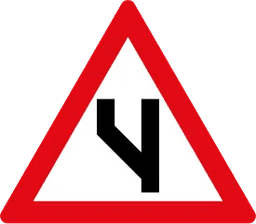
Dual Carriageway Begins (Left)
Warns drivers of the beginning of a dual carriageway, splitting to the left.

Dual Carriageway Ends Ahead (Left)
Warns drivers that the dual carriageway is ending from the left and will merge into a single lane.
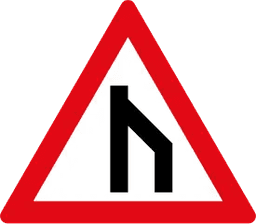
Dual Carriageway Ends Ahead (Right)
Warns drivers that the dual carriageway is ending from the right and will merge into a single lane.

Gentle Curve to the Left
Warns drivers of a gentle curve in the road to the left ahead.

Sharp Junction to the Left
Warns drivers of a sharp junction where a road branches off sharply to the left.
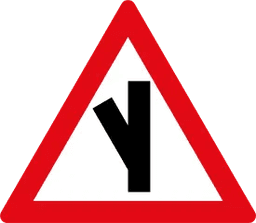
Sharp Reverse Junction to the Left
Warns drivers of two consecutive sharp junctions, first to the left and then to the right.
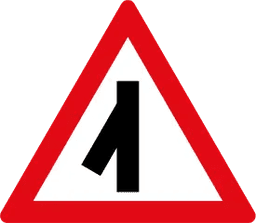
Sharp Reverse Junction to the Right
Warns drivers of two consecutive sharp junctions, first to the right and then to the left.
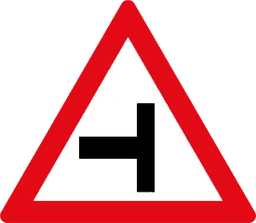
Side Road Junction (Right) Ahead
Warns drivers of an upcoming junction where a side road joins from the right.

Skewed T-Junction (Right) Ahead
Warns drivers of an upcoming skewed T-junction where a side road joins from the right.
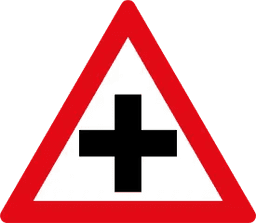
Crossroad Ahead
Warns drivers of an upcoming intersection where two roads cross.
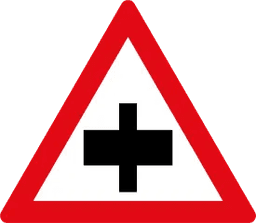
Crossroad Ahead without Priority
Warns of an upcoming crossroad where you do not have priority.

Roundabout Ahead Sign: Meaning, Rules, and How to Navigate Safely
A roundabout ahead sign is a triangular warning sign with a red border and a circular arrow symbol.
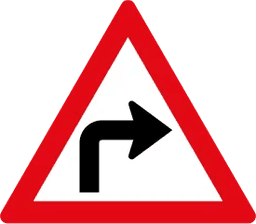
Sharp Curve to the Right
Warns drivers of a sharp curve in the road to the right ahead.

Sharp Junction to the Right
Warns drivers of a sharp junction where a road branches off sharply to the right.
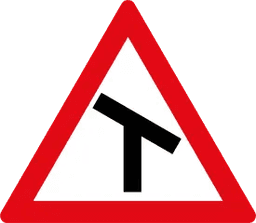
Skewed T-Junction (Left) Ahead
Warns drivers of an upcoming skewed T-junction where a side road joins from the left.
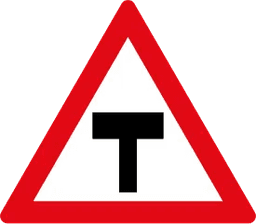
T-Junction Sign: Meaning and Rules
Warns drivers of an upcoming T-junction where the road ends and joins another road.

Staggered Junction Sign: Meaning and Rules
A staggered junction is a road layout where two side roads join the main road at different points, either left-then-right or right-then-left.
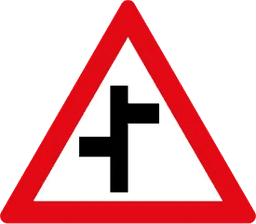
Staggered Junction (Right-Left) Ahead
Warns drivers of staggered side-road junctions where roads join from the right, followed by the left.
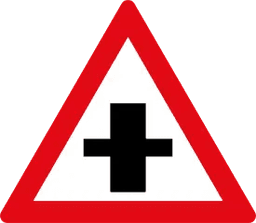
Crossroad Ahead with Priority
Warns of an upcoming crossroad where you have priority.
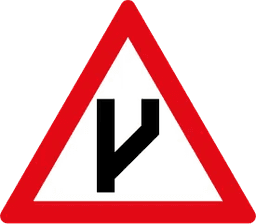
Dual Carriageway Begins (Right)
Warns drivers of the beginning of a dual carriageway, splitting to the right.

Fork in the Road Sign: Meaning and Rules
Warns drivers of an upcoming fork where the road splits into two paths.
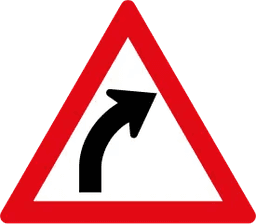
Gentle Curve to the Right
Warns drivers of a gentle curve in the road to the right ahead.
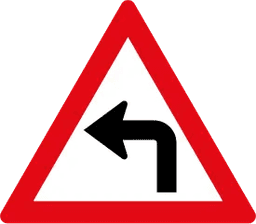
Sharp Curve to the Left
Warns drivers of a sharp curve in the road to the left ahead.
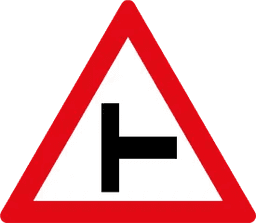
Side Road Junction (Left) Ahead
Warns drivers of an upcoming junction where a side road joins from the left.
Understanding Warning Road Signs
Warning road signs are designed to alert drivers to potential dangers or unusual conditions on or near the road ahead. These signs give drivers time to adjust their driving behavior, reducing the risk of accidents. Key features of warning road signs include:
- Triangular shape with a red border and white or yellow background
- Black symbols or text depicting the nature of the warning
- Positioned before the hazard to give drivers adequate time to respond
- Not legally enforceable but ignoring them can lead to dangerous situations
Warning signs cover a wide range of potential hazards, from changes in road layout to the presence of pedestrians or animals. They play a vital role in preparing drivers for what lies ahead on their journey.
Importance of Warning Road Signs in South African Driving
Warning road signs are critical for several reasons in the South African context:
- Diverse Road Conditions: South Africa has a variety of road types, from modern highways to rural unpaved roads. Warning signs help drivers navigate these diverse conditions safely.
- Wildlife Presence: In many areas, there's a risk of encountering wildlife on the road. Warning signs alert drivers to these potential hazards.
- Accident Prevention: By giving advance notice of hazards, these signs allow drivers to adjust their speed and driving behavior, significantly reducing the risk of accidents.
- Navigation Assistance: Some warning signs, such as those indicating sharp bends or intersections, help drivers anticipate changes in the road layout.
- Weather-Related Hazards: Signs warning of areas prone to strong winds, falling rocks, or flooding are particularly important in South Africa's varied climate.
Understanding and heeding warning signs is crucial for safe driving in South Africa and is an important part of the K53 driving system.
Tips for Recognizing and Responding to Warning Road Signs
To effectively use warning road signs for safer driving:
- Always be on the lookout for the distinctive triangular shape and red border of warning signs.
- When you see a warning sign, reduce your speed and increase your alertness.
- Try to anticipate what action might be required based on the warning given.
- Remember that the distance between the sign and the hazard may vary; stay alert until you've passed the warned condition.
- In areas with multiple hazards, you may see several warning signs grouped together. Pay attention to each one.
- Some warnings may be seasonal or conditional (e.g., "Slippery When Wet"). Adjust your interpretation based on current conditions.
- Practice identifying and responding to warning signs while using the K53 Learners App to improve your recognition and reaction skills.
Frequently Asked Questions about Warning Road Signs
Are warning signs legally enforceable like regulatory signs?
No, warning signs are not legally enforceable in the same way as regulatory signs. However, ignoring them can lead to dangerous situations and could be considered reckless driving, which is an offense.
Why are most warning signs triangular?
The triangular shape is universally recognized as a symbol of warning or caution. This distinct shape allows drivers to quickly identify that they're approaching a warning sign, even before they can read the specific message.
How far in advance of a hazard are warning signs typically placed?
The placement of warning signs varies depending on factors like the speed limit, visibility, and the nature of the hazard. Generally, they are placed to give drivers enough time to perceive the sign, understand its message, and take appropriate action before reaching the hazard.
What should I do if I can't understand a warning sign symbol?
If you encounter an unfamiliar warning sign while driving, the safest approach is to reduce your speed and proceed with caution. After your journey, look up the sign in the K53 manual or the K53 Learners App to understand its meaning for future reference.